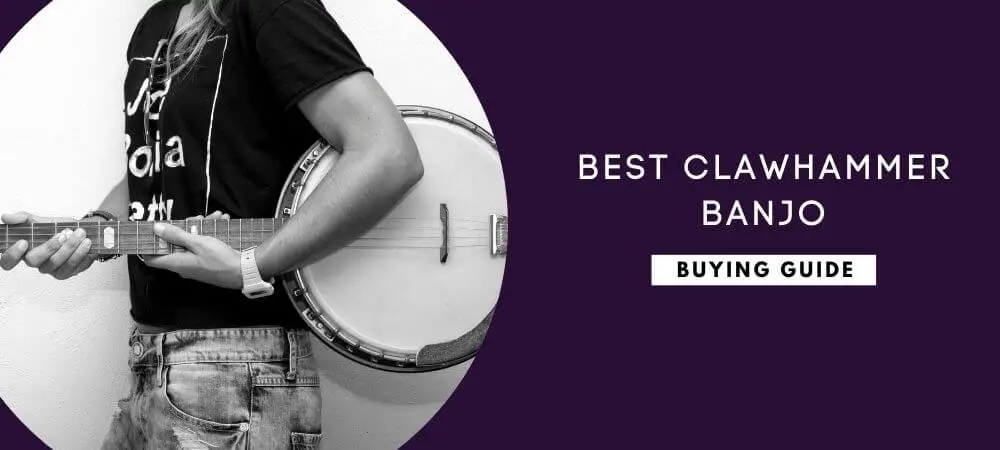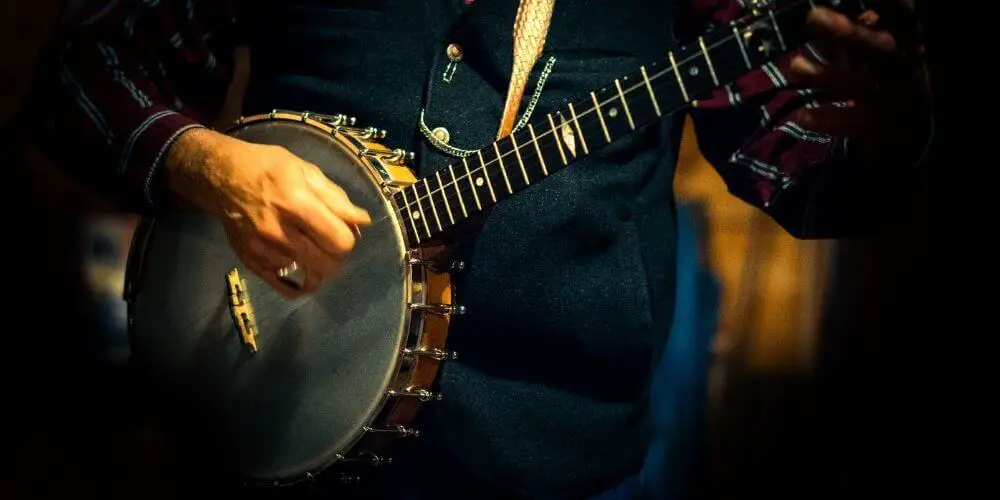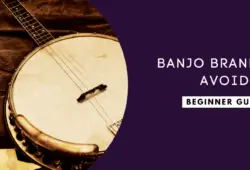Clawhammer banjos may popularly go by other names such as frailing or old-time banjos. Whichever name you choose, they all refer to the same banjo that’s closely associated with traditional American music.
The best clawhammer banjo not only produces a unique sound ideal for folk music, but it also uses a unique setup, which is the one major factor differentiating clawhammer from other banjos styles.
Let’s take a look.
Table of Contents
Best Clawhammer Banjo To Buy In 2024
1. Recording King Madison Open Back Banjo Review
This banjo comes with a 3-ply steam bent maple rim which allows for a warm mid-range sound ideal for clawhammer.
Another nice touch is the remo fiberskyn head that gives the banjo a nice plunky old-timey tone.
Additionally, the scooped rosewood fingerboard on this banjo is a nice touch that allows clawhammer style players to play over the neck easily.
The maple neck allows this banjo to have a dynamic response meaning you can play it quietly or loudly for a more expressive sound.
The adjustable truss rod on the neck ensures that you can keep the instrument’s neck nice and straight for comfortable playing.
- Great value for money.
- Good sounding banjo.
- Solid banjo with excellent craftsmanship.
- Does not come with a case or gig bag.
2. Gold Tone, 5-String Banjo (AC-1) Review: Best Beginner Banjo
This clawhammer banjo comes at an unbeatable price.
It perfectly combines affordability with a well-made, great-sounding instrument.
The slim banjo neck makes it extremely comfortable to hold, which is just the level of playability a beginner would be looking for.
Furthermore, it is incredibly lightweight, weighing under 4 lbs. Therefore making it ideal for travel or a child banjoist.
The composite rim is part of what makes it so lightweight, so rest assured this isn’t a flimsy instrument; it is pretty tough and durable.
- Ultra Lightweight.
- Very comfortable to play.
- Holds the tune very well.
- The gig bag provided isn’t of the best quality.
3. Deering Goodtime 5-String Banjo Review: Best Value for Money
The Deering Goodtime banjo has a great plunky sound.
Its round, full-bodied tone is just what every clawhammer player desires.
The slender maple neck is among the best you will ever find on any banjo, and the banjo has excellent intonation up the neck.
The action on this banjo is adjustable so that you can have it lower or higher depending on your playing style and preferences.
All in all, the Deering Goodtime banjo looks, plays, and sounds like it should cost much more than it does.
- Extremely lightweight.
- Excellent sound and playability.
- Has a 6-year warranty.
- The neck can be a bit too narrow for some players.
4. Deering Goodtime Americana Banjo Review
The Deering Goodtime Americana comes with a 12-inch rim, which is the biggest difference between this banjo and the Deering Goodtime.
This wider rim gives the Americana a fat tone.
You will notice that the sound is richer and has much more bass than what you would find on the typical open back banjo.
The Renaissance head on this banjo will appeal to many players because it gives a very authentic clawhammer sound that is much sought after.
The wonderfully laid-back sound of this banjo would be the perfect accompaniment for a vocalist.
- Sweet, warm tone.
- Easy to play.
- Very responsive.
- Lacks power on the higher notes.
5. Recording King RK-OT25-BR Madison Banjo Review
The scooped rosewood neck on this banjo makes it the ideal instrument for clawhammer players who prefer playing over the neck instead of over the head.
Furthermore, the banjo has planetary tuners, which are often preferred because they turn easier and hold their tuning much better.
You will typically only find planetary tuners on a high-quality banjo.
This is because these tuners cost much more than machine head tuners.
The Remo Fiberskyn head is another premium feature on this banjo, guaranteeing that classic clawhammer sound that’s plunky and old-timey.
- Premium quality construction.
- Loud mellow sound.
- Great playability.
- It doesn’t have accommodations for a strap.
6. Rover RB-20 Open Back 5 String Banjo Review
This Rover open back banjo is an instrument that’s been designed to perform faithfully and last a lifetime.
It is a starter banjo that offers traditional features with modern refinements and delivers all that at a great price point for entry-level players.
The neck feels very good and sturdy.
There is even an adjustable truss rod to help keep the neck as straight as possible at all times.
The guitar-style geared tuners work pretty great, and this banjo comes with a Vega-style armrest for enhanced comfort while playing.
- Affordably priced.
- Very durable.
- Great comfort and playability.
- The fifth string nut isn’t of the best quality.
7. Pyle PBJ60 Resonator Banjo Review: Best Budget Banjo
The striking appearance of this instrument is because it has been styled after the earlier models of the early 20th century.
It is a resonator banjo.
However, the best part is that the resonator is easily removable, so essentially, you are getting two instruments in one.
You can choose to play clawhammer while the resonator is fixed on the banjo, or you can remove the resonator.
Removing the resonator would allow you to get that authentic, mellow clawhammer sound of an open back banjo.
- Has a great tone.
- Comes with an armrest for added comfort.
- Excellent craftsmanship.
- The bridge isn’t of the best quality.
What To Consider When Buying A Clawhammer Banjo
No. Of Strings
You can play clawhammer on pretty much any five string banjo, as long as the instrument is playable and has a good setup. Playability means that your five string banjo needs to have a good neck, good action, level frets, and keeps in relatively good tune.
Clawhammer banjos have a slightly different setup than what you would find on the typical banjo. Banjos for clawhammer have the action set slightly higher, and the bridge and strings are slightly heavier. We shall discuss more of this in subsequent sections.
Resonator Or No Resonator?
Open backs are preferred because they emphasize the mellow tone of this style.
An open back banjo may come with a tone ring, which would color the sound and give the instrument some volume. If it has a tone ring, non-cast tone rings are preferred for playing clawhammer.
An open back banjo without a tone ring is called a backless banjo.
Backless banjos have the least amount of volume and sustain, and some players feel like this style has the ‘plunkiest’ most old-timey sound. This banjo style particularly suits players whose particular interest lies in roots music.
Some clawhammer players may choose to use a resonator banjo because of the increased volume and added comfort while playing. When using a resonator banjo, you won’t have the hooks and nuts of the open back digging into your thigh.
Also, on resonator banjos, the playing area is a distance from your belly, which some people find to be the ideal playing position. Nevertheless, it doesn’t hurt using resonator banjos to play clawhammer, and you can still get a good clawhammer tone on a resonator.
The one problem with using this banjo style appears to be the sustain. Resonator banjos have a lot of sustain that isn’t needed when playing clawhammer. A quick fix to neutralize this would be to stuff the banjo. Stuffing the pot kills the ringing, but be careful not to overstuff it because you would also kill the tone.
Another fix would be to control your right hand. Resonator banjos can sound too harsh or too loud when you beat on the strings aggressively. Try having a softer touch, and you will notice a remarkable difference in the sound produced.
Lastly, if the resonator truly isn’t working for your clawhammer playing style, you can opt to take it out permanently. Some banjos are designed with an easily removable resonator, so you can take it out when not needed.
Head
Modern banjos come with synthetic heads because these offer better resistance to weather and other environmental factors.
However, clawhammer players tend to prefer the tone of a traditional calf skinhead. These hide heads are also known as renaissance heads, and a modern material that imitates this old skinhead is the Fiberskyn head.
Hide heads are softer than their plastic counterparts, and they give the banjo an excellent sound that’s plunky, warm, round, and mellow, with less sustain. This is just the sound that clawhammer banjo players prefer.
You need a more muted sound with a warmer tone to play clawhammer style. The head tension on clawhammer banjos is often softer to give more of a plunky sound than the ringing sound you get from bluegrass instruments.
Neck
The neck width is important because it determines the banjo’s string spacing and scale length.
The clawhammer playing style has increased left-hand plucks and so it is preferable to have shorter, wider fingerboards with higher strings.
This is where the scooped-neck banjo thrives and as the name suggests, a scoop is carved out near the base of the neck.
A scooped-neck open back banjo has a scooped fingerboard and what this means is that above a certain point, there are no frets, and some material has been scooped or removed from the fingerboard.
The idea behind this scoop is to create more space between the springs and the fingerboard, therefore giving clawhammer players more room to play over the fretboard instead of over the head.
Playing clawhammer banjo over the fretboard is a style favored by many players because it gives them a different sound that perfectly suits their style of music.
A scooped neck banjo may also be called a fretless banjo, and this is because it gets rid of the high frets that many clawhammer players never used anyway.
This scooped feature comes in handy for many clawhammer players. However, it may not be a desirable option for those who play lead runs and therefore may need to go high up on the fingerboard.
High Action
Clawhammer banjos are typically set up with high action above the high end of the fretboard. This high action gives more room for clawhammer playing, so the strings don’t slap when playing clawhammer.
Also, the higher action allows for easier pull-offs and hammer-ons because the strings are a little bouncier.
To reduce slap even further, heavier strings may be used to play clawhammer banjo, which also provides a different tone.
High action means that the bridge is slightly taller than what you would find on a standard banjo. It may also be preferable to have the bridge made from softer woods that further enhance that plunk sound clawhammer players desire.
At the same time, however, the strings should be low enough over the frets near the head to allow for comfortable playing.
Long Neck Banjo
Long neck banjos are five string folk-style banjos that combine clawhammer and up-picking.
Pete Seeger popularized this folk music genre and playing style in the 1960s, and it typically comprises mixing melodies and playing around with chords.
Traditionally, the long neck banjo was built as an open back, but you can find some models that have resonators. Often, this banjo is tuned lower, and the long neck design comes from the fact that the banjo has 25 frets instead of the standard 22 frets.
When you tune a 25-fret banjo to the same interval as a standard 22-fret banjo with G tuning, you will create an E tuning that you find on most long neck banjos.
Long necks are an excellent banjo choice for players who like to sing folk music while playing. The low E tuning has incredible depth and richness and perfectly fits singing ranges, making it the best clawhammer banjo to accompany the voice.
Adding a capo on the third fret would convert it back to G tuning, allowing you to quickly change keys while banjo playing.
Clawhammer Banjo FAQs
Why Is It Called A Clawhammer Banjo?
The clawhammer banjo derives its name from the method of playing whereby you strike the strings using the back of your index or middle finger nail while alternately plucking with your thumb.
The claw-like shape of your hand, combined with the ‘hammering’ style in which you strike the strings, is what results in the clawhammer technique and, consequently, the clawhammer banjo.
How Much Does A Clawhammer Banjo Cost?
The best clawhammer banjos could cost you well over $1,000, with prices going as high as $8,000 for a professional clawhammer style banjo.
You don’t have to spend that much, though. You can find a nice beginner banjo for about $600 or even much less, but this will require some digging to unearth a gem.
Nevertheless, do not fuss too much about finding the perfect banjo. Instead, the focus should be on finding the best banjo for clawhammer that perfectly suits your playing style and sounds good to you.
After all, your tastes and preferences will develop as you play banjo and learn more techniques. So, it won’t make sense to splurge on a high-end banjo you aren’t sure you will play for a lifetime. Simply allow yourself to get the best banjo you can comfortably afford.
What Are The Best Clawhammer Banjo Brands?
Oscar Schmidt is a great brand that stands behind its banjos 100%.
Deering banjo company makes its instruments under ruthless quality control, and Deering banjos are known for their durability and simple signature design that employs top-notch craftsmanship.
Washburn is another stellar brand that’s been crafting impressive banjos since the late 1800s. These banjos have impeccable design, quality, and material construction, and they are reasonably affordable too.
Gold Tone banjos are famed for having great attention to detail and impressive craftsmanship that ensures you get a high-quality sound from your instrument.
Difference Between Clawhammer Banjo Vs. Bluegrass?
While both clawhammer and bluegrass are played on five-string banjos, clawhammer style is a lot more laid back than bluegrass, which is evident in its gentler, more melodic sound.
Most players feel like they need a louder instrument to play bluegrass, and this is why bluegrass banjos often come with tone rings, flanges, and resonators, all aimed at increasing volume and sustain for a powerful sound with more ring.
Clawhammer banjos often lack these accommodations, and so they are usually relatively lightweight and typically cost less than the average Scruggs style banjo.
As far as the sound quality goes, clawhammer banjos have more plunk than ring, whereas bluegrass banjos have more ring than plunk.
Clawhammer banjos are designed for playing individual notes and strumming, whereas bluegrass banjos typically use a plucking style whereby strings are picked in a complex pattern.
Can You Play Clawhammer On Any Banjo?
You can learn clawhammer techniques on any 5 string banjo as long as it has a good neck. However, you can only play clawhammer on a clawhammer banjo because these are designed to give you the ideal plunk sound for folk music.
Also, clawhammer style requires a different banjo set up from other styles, so for playability, you are better off using a banjo for clawhammer that’s been set up correctly for that style and technique.
Is Clawhammer Banjo Easier?
People have often regarded the clawhammer banjo as being easier than the bluegrass banjo. However, even the best clawhammer banjo players will agree that this isn’t necessarily true.
On the one hand, clawhammer uses a few basic strokes, which, once mastered, everything else will fall into place. The challenge is learning the basic clawhammer stroke to achieve the bum-ditty rhythm.
The essence of clawhammer style is based on 2-finger picking, whereby only the thumb and middle or index fingers are used to strum. Also, the chosen finger only uses down picking style, and the thumb doesn’t pick on the downbeat.
Conclusion
Banjos come in a wide range of styles, and the best clawhammer banjo for one player might not necessarily be a great fit for another player. This is why it is important to take an individualistic approach when looking for your next banjo, regardless of whether you are buying a used one or a new banjo.
Ultimately, all that matters is what offers you the best combination of sound, comfort, and playability.









![How Hard Is It to Play the Banjo? [ANSWERED]](https://musictechhub.com/wp-content/uploads/2020/04/How-Hard-Is-It-to-Play-the-Banjo-250x170.png)

